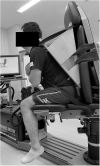Time course of changes in the range of motion and muscle-tendon unit stiffness of the hamstrings after two different intensities of static stretching
- PMID: 34520498
- PMCID: PMC8439484
- DOI: 10.1371/journal.pone.0257367
Time course of changes in the range of motion and muscle-tendon unit stiffness of the hamstrings after two different intensities of static stretching
Abstract
Objectives: The purpose of this study was to examine the time course of changes in the range of motion and muscle-tendon unit stiffness of the hamstrings after two different intensities of static stretching.
Methods: Fourteen healthy men (20.9 ± 0.7 years, 169.1 ± 7.5cm, 61.6 ± 6.5kg) received static stretching for 60 seconds at two different intensities based on the point of discomfort (100%POD and 120%POD) of each participant, in random order. To evaluate the time course of changes in the flexibility of the hamstrings, the knee extension range of motion (ROM), passive torque at end ROM, and muscle-tendon unit stiffness were measured pre-stretching, post-stretching, and at both 10 and 20 minutes after static stretching.
Results: For both intensities, ROM and passive torque at pre-stretching were significantly smaller than those at post-stretching (p < 0.01 in both intensities), 10 minutes (p < 0.01 in both intensities), and 20 minutes (p < 0.01 in both intensities). The muscle-tendon unit stiffness at pre-stretching was significantly higher than that at post-stretching (p < 0.01), 10 minutes (p < 0.01), and 20 minutes (p < 0.01) only in the 120%POD, but it showed no change in the 100%POD.
Conclusion: The results showed that ROM and passive torque increased in both intensities, and the effects continued for at least 20 minutes after stretching regardless of stretching intensity. However, the muscle-tendon unit stiffness of the hamstrings decreased only after static stretching at the intensity of 120%POD, and the effects continued for at least 20 minutes after stretching.
Conflict of interest statement
The authors have declared that no competing interests exist.
Figures
Similar articles
-
Influence of High Intensity 20-Second Static Stretching on the Flexibility and Strength of Hamstrings.J Sports Sci Med. 2020 May 1;19(2):429-435. eCollection 2020 Jun. J Sports Sci Med. 2020. PMID: 32390737 Free PMC article.
-
Association between static stretching load and changes in the flexibility of the hamstrings.Sci Rep. 2021 Nov 5;11(1):21778. doi: 10.1038/s41598-021-01274-7. Sci Rep. 2021. PMID: 34741110 Free PMC article.
-
Acute Effects of the Different Intensity of Static Stretching on Flexibility and Isometric Muscle Force.J Strength Cond Res. 2017 Dec;31(12):3403-3410. doi: 10.1519/JSC.0000000000001752. J Strength Cond Res. 2017. PMID: 27984497 Clinical Trial.
-
Critical evaluation and recalculation of current systematic reviews with meta-analysis on the effects of acute and chronic stretching on passive properties and passive peak torque.Eur J Appl Physiol. 2024 Nov;124(11):3153-3173. doi: 10.1007/s00421-024-05564-6. Epub 2024 Jul 27. Eur J Appl Physiol. 2024. PMID: 39066912 Free PMC article.
-
Effects of stretching intensity on range of motion and muscle stiffness: A narrative review.J Bodyw Mov Ther. 2022 Oct;32:68-76. doi: 10.1016/j.jbmt.2022.04.011. Epub 2022 Apr 20. J Bodyw Mov Ther. 2022. PMID: 36180161 Review.
Cited by
-
Comparison Between High- and Low-Intensity Static Stretching Training Program on Active and Passive Properties of Plantar Flexors.Front Physiol. 2021 Dec 17;12:796497. doi: 10.3389/fphys.2021.796497. eCollection 2021. Front Physiol. 2021. PMID: 34975544 Free PMC article.
-
Using Daily Stretching to Counteract Performance Decreases as a Result of Reduced Physical Activity-A Controlled Trial.Int J Environ Res Public Health. 2022 Nov 23;19(23):15571. doi: 10.3390/ijerph192315571. Int J Environ Res Public Health. 2022. PMID: 36497646 Free PMC article. Clinical Trial.
-
Effects of High-Intensity Stretch with Moderate Pain and Maximal Intensity Stretch without Pain on Flexibility.J Sports Sci Med. 2022 Jun 1;21(2):171-181. doi: 10.52082/jssm.2022.171. eCollection 2022 Jun. J Sports Sci Med. 2022. PMID: 35719229 Free PMC article.
-
Effects of Speed and Amplitude of Dynamic Stretching on the Flexibility and Strength of the Hamstrings.J Sports Sci Med. 2022 Dec 1;21(4):608-615. doi: 10.52082/jssm.2022.608. eCollection 2022 Dec. J Sports Sci Med. 2022. PMID: 36523896 Free PMC article.
-
Comparison Between the Effects of Transfer Energy Capacitive and Resistive Therapy and Therapeutic Ultrasound on Hamstring Muscle Shortness in Male Athletes: A Single-Blind Randomized Controlled Trial.Galen Med J. 2023 Aug 19;12:e2981. doi: 10.31661/gmj.v12i.2981. eCollection 2023. Galen Med J. 2023. PMID: 38989035 Free PMC article.
References
-
- Takeuchi K, Nakamura M, Kakihana H, Tsukuda F. A Survey of static and dynamic stretching protocol. Int J Sport Heal Sci. 2019;17: 72–79. doi: 10.5432/ijshs.201829 - DOI
-
- Simenz CJ, Ebben WP, Dugan CA, Ebben WP. Strength and Conditioning Practices of National Basketball Association Strength and Conditioning Coaches. 2005;19: 495–504. - PubMed
-
- Behm DG, Blazevich AJ, Kay AD, McHugh M. Acute effects of muscle stretching on physical performance, range of motion, and injury incidence in healthy active individuals: A systematic review. Applied Physiology, Nutrition and Metabolism. National Research Council of Canada; 2016. pp. 1–11. doi: 10.1139/apnm-2015-0235 - DOI - PubMed
-
- Magnusson SP, Simonsen EB, Aagaard P, Boesen J, Johannsen F, Kjaer M. Determinants of musculoskeletal flexibility: viscoelastic properties, cross-sectional area, EMG and stretch tolerance. Scand J Med Sci Sports. 1997;7: 195–202. Available: http://www.ncbi.nlm.nih.gov/pubmed/9241023. doi: 10.1111/j.1600-0838.1997.tb00139.x - DOI - PubMed
Publication types
MeSH terms
LinkOut - more resources
Full Text Sources



